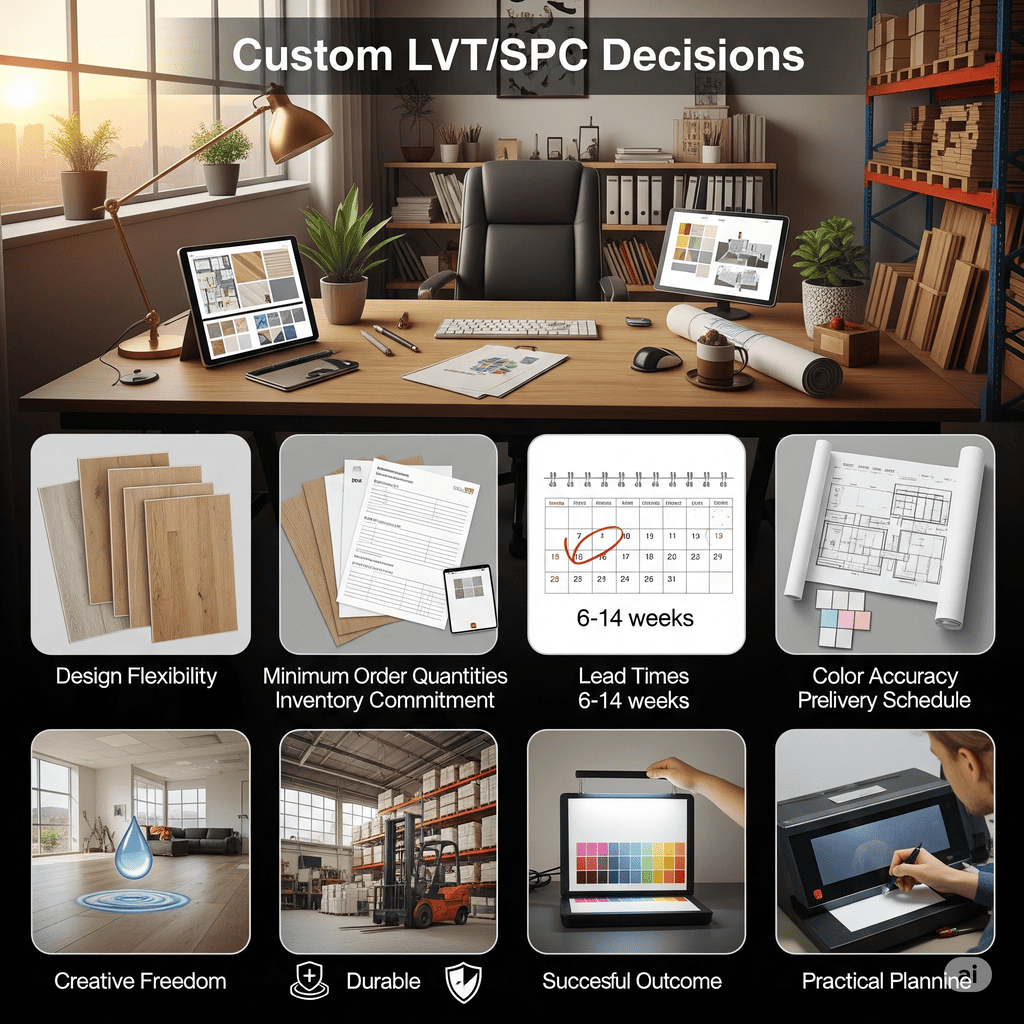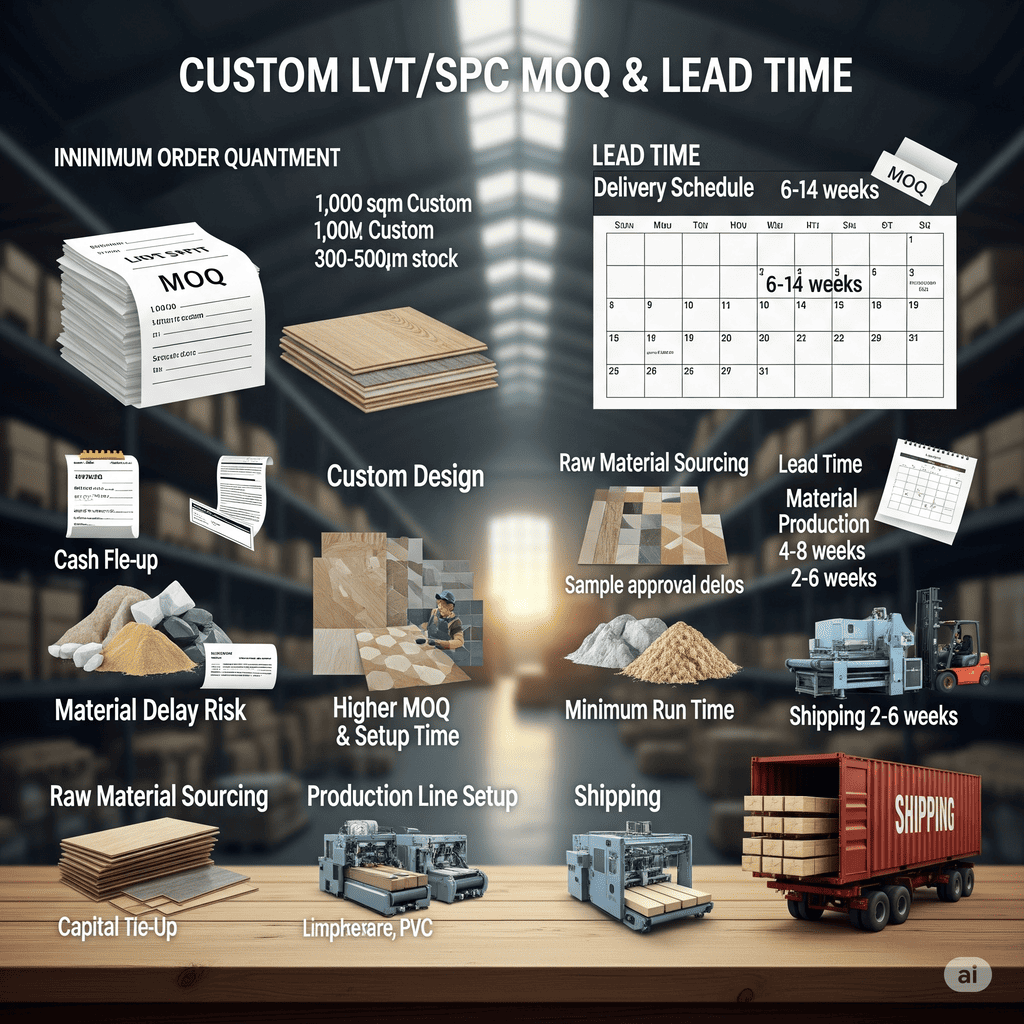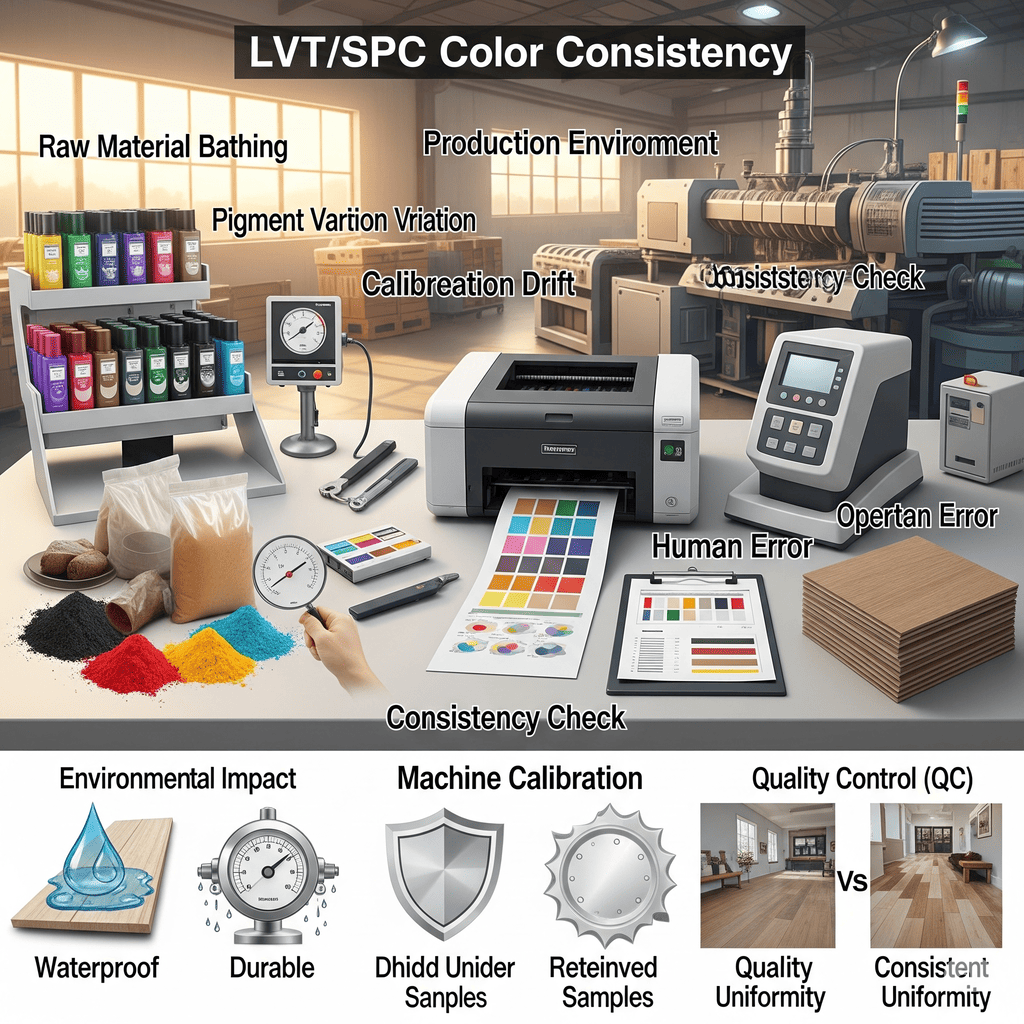Are you an importer of LVT or SPC flooring looking to offer unique designs? Many buyers face challenges with custom orders, from unexpected costs to color consistency issues. This can impact your sales and customer satisfaction.
Choosing custom LVT or SPC flooring means balancing design flexibility with practical considerations like minimum order quantities, lead times, and crucial color accuracy. Importers must understand these elements to ensure successful projects and high-quality products.

As a factory owner, I see many importers like Aiden and Lori navigate the world of custom flooring. LVT typically features a flexible PVC core, while SPC uses a rigid core made from limestone and stabilizers. Getting custom orders right ensures smooth operations and happy customers. Let’s look at the key points you need to consider.
What are the MOQ & Lead Time implications for custom LVT & SPC flooring?
Do you need to manage your inventory and cash flow effectively for custom orders? Many importers find that high minimum order quantities (MOQ) and long lead times can tie up capital and create storage issues.
Minimum Order Quantity (MOQ) and lead time directly affect an importer’s cash flow, inventory levels, and ability to meet market demand. Custom LVT and SPC flooring often require higher MOQs due to specific production setup, while lead times depend on material sourcing, production schedules, and shipping.

When choosing custom LVT or SPC flooring, MOQs and lead times are vital. Unique designs need specific materials and machine adjustments. This requires a base production volume for efficiency. Custom MOQs often start around 1,000 square meters per design. Stock designs can be lower, from 300 to 500 square meters. A 20-foot container, holding 1,500 to 2,000 square meters, is a common benchmark for orders. Smaller custom orders mean higher changeover costs. This is why MOQs exist.
Lead time covers everything from order confirmation to shipping. It includes material sourcing, production, and quality checks. Production typically takes 4 to 8 weeks, influenced by design complexity and sample approval. Shipping adds 2 to 6 weeks, making total lead times 6 to 14 weeks. For importers like Aiden, long lead times can mean missing sales seasons. For Lori, it means delayed distribution. We ensure transparency and plan closely with clients to manage expectations effectively.
| Factor | Impact on MOQ | Impact on Lead Time |
|---|---|---|
| Custom Design | Often 1,000 sqm per design (higher than stock) | Requires 1-2 weeks for sample approval, new tooling |
| Raw Material Sourcing | High MOQ for unique colors/patterns | Long lead times if custom materials are needed |
| Production Line Setup | Requires minimum run to optimize machine use | Time needed for setup, testing, and production runs |
| Shipping | Consolidated shipping may increase effective MOQ | Sea freight (2-6 weeks) adds significant time |
| Overall | Stock designs may be 300-500 sqm, faster | Total lead time typically 6-14 weeks |
Knowing these factors helps you plan your purchases better. It also helps you avoid surprises that can affect your business. We always aim to find a balance between custom needs and efficient production.
What technical challenges arise in initial color matching for custom LVT & SPC flooring?
Have you ever received a sample that looks perfect, but then the bulk order is slightly off? Initial color matching for custom LVT and SPC flooring1 is a common challenge for importers, leading to potential discrepancies and frustration.
Initial color matching for custom LVT and SPC flooring faces technical hurdles like variations in raw material pigments, differences in viewing light, and the subjective nature of human color perception. Achieving an exact match from a small sample to a mass production run requires precise laboratory work and multiple approval stages.

Achieving the exact color for custom flooring is complex. When clients provide a sample, we must translate it into a vinyl product using specialized lab equipment. Formulating precise ink mixtures is challenging, especially for non-standard colors. Raw materials, like pigments and PVC resin, can subtly affect the final shade. Printing accuracy is also vital, as equipment or ink quality variations can cause discrepancies.
Lighting conditions greatly influence color perception. A color looks different under natural light versus indoor LEDs. We use controlled lighting booths to ensure accuracy in various environments. Human color perception also varies. This makes clear communication essential. We send multiple samples for client approval. This iterative process, while time-consuming, prevents future quality issues. Precision in color matching is key for successful custom projects.
| Challenge | Description | Solution |
|---|---|---|
| Color Formulation | Creating precise ink mixtures for unique shades | Precise lab formulation, advanced color management software |
| Raw Material Variation | Pigments and base materials can have slight inherent differences | Strict incoming material inspection, consistent suppliers |
| Printing Technology | High-definition printing accuracy for decorative layer | Use high-resolution printers, regular calibration |
| Lighting Conditions | Color appears different under various light sources | Use standardized light booths (e.g., D65, TL84) for evaluation |
| Approval Process | Delays in feedback from client can slow down matching | Clear communication channels, defined approval timelines |
This detailed approach helps us manage your expectations. It ensures that the color you approve is the color you get.
What challenges exist in maintaining color consistency across custom LVT & SPC batches?
After approving the initial color, are you worried about future orders matching perfectly? Maintaining color consistency across multiple production batches of custom LVT and SPC flooring is a significant hurdle that can lead to quality issues for importers.
Maintaining color consistency across custom LVT and SPC flooring batches is challenging due to slight variations in raw material inputs, environmental factors like temperature and humidity during production, and human error in machine calibration. Robust quality control protocols and precise process management are essential to ensure uniformity.

Maintaining color consistency across multiple batches of custom LVT or SPC flooring is a significant challenge. A client like Lori expects future orders to match perfectly. This requires strict control over our production environment. Even minor fluctuations in extrusion temperature or raw material mixing ratios can cause slight color shifts. Machines need constant monitoring and calibration to prevent variations.
Raw material batch variations also pose a challenge; pigments from the same supplier can have tiny differences. To counter this, CloudsFlooring implements stringent in-process quality control. We take samples at regular intervals during production, comparing them against approved standards. This helps us catch any color drift early. We also retain control samples from every batch. Our goal is to minimize quality differences, preventing shipment delays or customer complaints.
| Factor | Impact on Consistency | Mitigation Strategy |
|---|---|---|
| Raw Material Batching | Slight variations in pigment strength or hue | Strict supplier QC, pre-blending, lab testing |
| Production Environment | Temperature and humidity can affect ink/material flow | Controlled environment, stable conditions |
| Machine Calibration | Variations in printing equipment settings | Regular calibration, standardized processes |
| Human Error | Incorrect settings or material handling | Comprehensive training, standardized operating procedures |
| Quality Control (QC) | Inconsistent inspections or tools | Regular spectrophotometer use, random sampling |
We put a lot of effort into these steps. This ensures that every plank of flooring you receive is consistent with your approved color.
How do raw material variations and QC impact custom LVT & SPC color accuracy?
Do you ever wonder how the very ingredients of your flooring affect its final look? Raw material variations play a critical role in the color accuracy of custom LVT and SPC flooring, and inadequate quality control can lead to significant discrepancies.
Raw material variations, particularly in pigments, PVC resin, and calcium carbonate, profoundly impact the final color accuracy of custom LVT and SPC flooring. Rigorous incoming quality control (QC) of these materials is essential. It prevents discrepancies. This ensures the finished product matches the approved color sample and meets client expectations.

Raw material variations significantly impact the color accuracy of custom LVT and SPC flooring. While pigments are critical, PVC resin, calcium carbonate, and even additives can subtly influence the final color. Different suppliers or batches of these base materials can have slight compositional variations. For example, the purity of limestone can affect how colors appear. Using unchecked materials can easily cause color shifts.
Therefore, stringent incoming quality control1 is essential at CloudsFlooring. We test all raw materials in our lab for purity, consistency, and interaction with pigments before production. This proactive check identifies potential issues early, preventing large-scale discrepancies. For importers like Aiden, meticulous material checks ensure top quality and peace of mind. Without strict QC, the risk of receiving goods that don’t match approved samples increases, leading to costly rejections and delays.
| Raw Material Component | Impact on Color Accuracy | QC Measure |
|---|---|---|
| Pigments | Direct influence on hue, saturation, and lightness | Spectrophotometer analysis, consistency checks |
| PVC Resin (LVT/SPC) | Base color can subtly affect final shade, clarity | Purity testing, color stability analysis |
| Calcium Carbonate (SPC) | Affects opacity, brightness, and overall tone | Whiteness index, particle size distribution, purity tests |
| Stabilizers/Additives | Minor impact, but can cause yellowing or discoloration over time | Chemical composition analysis, aging tests |
| Wear Layer | Can alter perceived depth or clarity of the color | Transparency and clarity checks, thickness measurement |
This layered approach to raw material quality ensures that the foundation of your custom flooring is always correct.
Why are Delta E and approval processes crucial for successful custom LVT & SPC projects?
Are you tired of subjective color discussions and endless back-and-forth? Relying on clear metrics and a structured approval process is vital for ensuring custom LVT and SPC flooring projects meet your exact color specifications without frustrating delays.
Delta E2 values provide an objective, numerical standard for color difference, eliminating guesswork in custom LVT and SPC flooring projects. A structured approval process, involving pre-production samples and clear communication, is crucial for securing client agreement. It prevents costly reworks and ensures the final product meets specified color accuracy.

For custom flooring, objective color measurement is crucial. Delta E (ΔE) quantifies the difference between two colors numerically. It provides an objective standard, eliminating guesswork. A Delta E below 1.0 is generally imperceptible. Values of 1.0-2.0 are barely perceptible but often acceptable. Values above 2.0 indicate a noticeable difference. At CloudsFlooring, we use spectrophotometers to measure Delta E, ensuring colors are within acceptable tolerances, typically ≤ 2-3 for most projects.
Beyond Delta E, a structured approval process is vital. Importers like Lori need a pre-production sample (PPS) made with actual materials and processes. This allows for thorough review and formal approval. This process prevents misunderstandings and costly reworks. While digital mock-ups are helpful, a physical sample is essential for final sign-off. This comprehensive approach ensures both parties agree on the final color, protecting everyone involved and guaranteeing consistent product quality.
| Delta E Value Range | Perceived Difference | Application in Flooring |
|---|---|---|
| 0.0 – 1.0 | No perceptible difference | Ideal for critical color matching, highly desired |
| 1.0 – 2.0 | Barely perceptible difference, may be acceptable | Good for most production runs, often within tolerance |
| 2.0 – 3.5 | Noticeable difference, may be acceptable for some | Requires review; often indicates a slight color shift |
| 3.5 – 5.0 | Clearly noticeable difference | Typically unacceptable for custom orders; needs correction |
| > 5.0 | Very noticeable difference | Unacceptable; requires complete rework |
Using Delta E and a clear approval process ensures your custom flooring projects are successful and meet your high standards.
Conclusion
Custom LVT and SPC flooring offers great potential for importers. Yet, it demands attention to MOQs, lead times, color matching, and consistency. By understanding these points and leveraging robust QC and approval processes, you ensure top-quality products for your market.
The above data is for reference only.
